What Is a Tool Changer?

A tool changer is a tool changing mechanism and system used to add tool changing functions to articulated robots and processing machines (machining centers, etc.).
The tool changer is a mechanism and system used to add a tool changing function to an articulated robot or a machining center.
Some tool changers are equipped with an air blow function to remove dust from the tool clamping area in addition to tool loading and unloading. Some tool changers can supply compressed air, water, or electrical signals to the tool.
Uses of Tool Changers
In the past, tool changers were mostly used to change tools on processing machines, but as the introduction of articulated robots increases, tool changers for articulated robots are becoming more common.
Tool changers are used on machining centers to perform various machining operations automatically without the need for human tool change. The tool changer automatically performs tool change, tool height measurement, and runout measurement. This reduces the need for human operators to change tools, check tool height and runout after tool change, and furthermore, by automating parts loading and unloading, it is possible to fully automate the parts machining process.
In articulated robots, this tool changer is generally used to change the hand at the end of the robot. Robot hands have various functions such as gripping by air chuck, rotation by motor, and vacuum suction. Therefore, for articulated robots, tools are available that can be supplied with compressed air, water, vacuum, or electrical signals. By using a tool changer, a single robot can perform multiple tasks, thus helping to improve the efficiency of the use of articulated robots.
Principle of Tool Changer
There are various types of tool changers, but most of them use compressed air to clamp or pull up the tool.
For machining tools, an air cylinder is mainly used to hold the tool in place by pulling up the knob on the tool’s mounting section. Many of the tool mounting parts are tapered (BT and other standards are available), and contact with the taper maintains repeatability of the tool position.
In addition, the tool stocker, together with the tool stocker, is called an ATC (auto tool changer) in machining centers and is treated as a single system. There are different types of stockers, such as disk type and chain-driven type.
For articulated robots, each company has its own clamping mechanism driven by compressed air, often using cams. Fluid supply parts, such as compressed air, water, and vacuum, use seals such as O-rings to prevent leakage. Contact probes are used for electrical signals.
Robot hands are designed by automatic machinery manufacturers to suit their applications, and stockers and other parts are manufactured accordingly, so few are sold as standard products.